

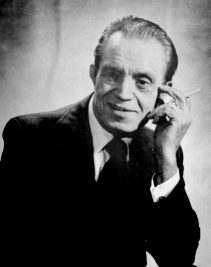 Slydini
Slydini
The Master of Misdirection
(1901-1991)
Born: Quintino Marucci
Palermo, Italy
Inducted: 2004

Compiled and written by Steve Dacri
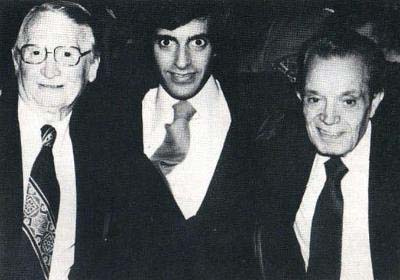 I
was a student of Tony Slydini, long before I started my career in magic.
I was still living in Boston, and I would take the bus or train into New
York City to meet the master. I was originally introduced to him by the
late Louis Tannen, founder of Tannens Magic, along with David Copperfield.
He agreed to take me on as a student, only after I demonstrated some coin
moves for him.
I
was a student of Tony Slydini, long before I started my career in magic.
I was still living in Boston, and I would take the bus or train into New
York City to meet the master. I was originally introduced to him by the
late Louis Tannen, founder of Tannens Magic, along with David Copperfield.
He agreed to take me on as a student, only after I demonstrated some coin
moves for him.
(At left: Lou Tannen, David Copperfield and Tony Slydini)
I often slept on Tony's couch, and continued with the lessons the following day.
(At left: Student and teacher, Steve with Tony in New York City around 1974.)
We became great pals, cooked together (he loved to cook. He was, after all, Italian!) and visited with other magicians in New York, such as Frank Garcia, Al Flosso and Coe Norton and Derek DIngle. After the first string of lessons, Tony stopped taking money from me. He didn't need the money, and said he was retired, so he did not want to have any more students. No matter how hard I tried to give him money, he always refused, and often would get angry, until I eventually stopped trying
.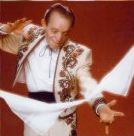 I always would bring some wine, special sauce, good tomatoes, whatever,
whenever I visited him. Besides the learning, we had a lot of fun. He
loved to tell jokes, in his broken accent, and he loved to eat, both at
home in his own kitchen, and out in Little Italy.
I always would bring some wine, special sauce, good tomatoes, whatever,
whenever I visited him. Besides the learning, we had a lot of fun. He
loved to tell jokes, in his broken accent, and he loved to eat, both at
home in his own kitchen, and out in Little Italy.
I owe so much to Tony, for his brilliant skill, remarkable coaching and generous soul. I also have a few wonderful recipes that I occasionally cook up. Between him and Dai Vernon (with plenty of Frank Garcia, Charlie Miller and Al Goshman thrown in) I became the performer that I am today. Without any of these great men, I would probably be selling pencils on the corner somewhere.
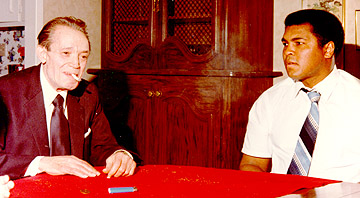 Tony
Slydini was born in Italy as Quintino Marucci. Slydini was the son of
an amateur magician who encouraged him to pursue sleight of hand at an
early age. Slydini was attracted to the psychological elements of the
art that most appealed to the young Tony in the beginning, which would
later manifest itself in his magic in the form of precise and expert use
of misdirection.
Tony
Slydini was born in Italy as Quintino Marucci. Slydini was the son of
an amateur magician who encouraged him to pursue sleight of hand at an
early age. Slydini was attracted to the psychological elements of the
art that most appealed to the young Tony in the beginning, which would
later manifest itself in his magic in the form of precise and expert use
of misdirection.
(At left: Tony Slydini fools Mohammad Ali)
He was also taken by the relationship between the magician and his audience, which fueled his desire to be a close-up artist.
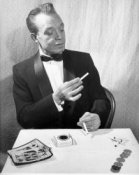 While
still young, Slydini and his family left Italy to live in Argentina. It
was there that Slydini began to experiment more seriously with magic.
"In Argentina,", he says, "I created my own magic. There
were many ways to go. I went the right way. I created magic."
While
still young, Slydini and his family left Italy to live in Argentina. It
was there that Slydini began to experiment more seriously with magic.
"In Argentina,", he says, "I created my own magic. There
were many ways to go. I went the right way. I created magic."
Slydini worked in South America's vaudeville in South America for a time, but soon the Depression hit and work became scarce. In 1930, he moved to New York City, where work was also scarce, especially for a young man who spoke no English. Finally, Slydini found work in a museum on Forty-second Street. From there, Slydini found work in carnivals and sideshows.
Once Slydini went to visit his sister in Boston, and began looking for work. Thanks for a lucky break, Slydini managed to impress an agent there and landed a job for $15 a day for a three-day job. His skill was apparent to those who saw him on those three days, including another agent who offered him another contract. This strak continued for some time; Slydini ended up performing in Boston for seven years. But New York called to the now successful Slydini, and he moved back to there.
It's important to note that, at this time, close-up artistry didn't exist as it does now. Back in those days, close-up was used merely as an introduction to platform or stage shows. Slydini was breaking new ground, but only he seemed to realize it. In 1945, in New Orleans, he began to see the new land on which he was treading.
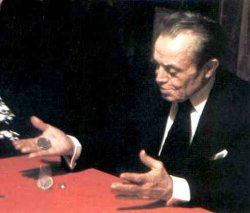 At
that time, in New Orleans, there was a magic convention that Slydini used
to show his own special brand of magic. "The world didn't recognize
the close-up art then," he says. "No one knew I had this beautiful
thing. Even magicians didn't know what it was. When I went to New Orleans,
I had a standing ovation for twenty minutes. 'Slydini's magic is different,'
they said."
At
that time, in New Orleans, there was a magic convention that Slydini used
to show his own special brand of magic. "The world didn't recognize
the close-up art then," he says. "No one knew I had this beautiful
thing. Even magicians didn't know what it was. When I went to New Orleans,
I had a standing ovation for twenty minutes. 'Slydini's magic is different,'
they said."
Slydini, of course, didn't invent close-up magic; that had been around for centuries. But Slydini's style of close-up was something that had never been seen before. Slydini was one of the first to show close-up magic as an art rather than as a lead-in to bigger and grander illusions. Slydini's magic was impromptu; rather than follow a set sequence of tricks, he allowed his audience and the situation to dictate his show. "I do a trick better," he said, "if I like the trick, but if they like it, and I don't like it, I will do it for them anyway."
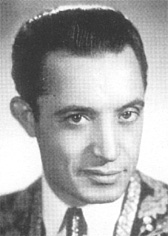 But
to Slydini, magic was more than just tricks. "You have to know all
the details. Something is happening all the time. You have to understand
every moment. You have to hold people, how to entertain them. You must
be aware of the commonsense of things, the movements of the body, where
to look and how to sit or stand."
But
to Slydini, magic was more than just tricks. "You have to know all
the details. Something is happening all the time. You have to understand
every moment. You have to hold people, how to entertain them. You must
be aware of the commonsense of things, the movements of the body, where
to look and how to sit or stand."
A man of continental charm, sharp wit, undeniable skill and subtlety, Slydini delighted in performing, whether for laypersons or magicians. Bringing precision, grace, and intelligence to the table, Slydini could baffle them all as well as he entertained.
Dick Cavett once asked Dai Vernon who could still fool him. Nobody, the Professor replied almost regretfully, then added with a smile, "Of course, Tony can."
| elm
- shows - school
- mall -
books - organizations -
contact us - hall of fame -
news
©2000 - 2009 MagicWebChannel.com |